A Merry Christmas to all from ProFantasy. Thank you to Character Artist 3 contributor Rich Longmore for this image.
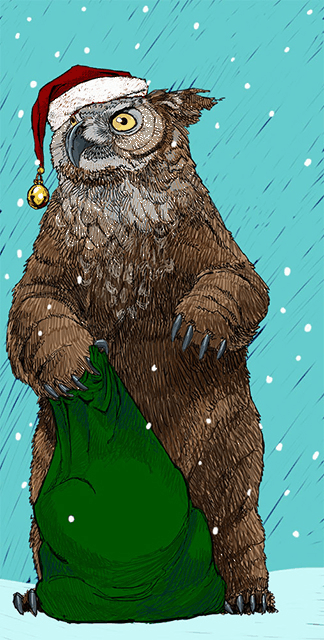
A Merry Christmas to all from ProFantasy. Thank you to Character Artist 3 contributor Rich Longmore for this image.

 Downloads from ProFantasy make great gifts. As the buyer, you don’t have to do the actual download yourself. Instead, you can give the recipient some simple download details that are included in your online receipt. These details allow the one receiving the gift to download the software and documentation themselves, at anytime and anywhere.
Downloads from ProFantasy make great gifts. As the buyer, you don’t have to do the actual download yourself. Instead, you can give the recipient some simple download details that are included in your online receipt. These details allow the one receiving the gift to download the software and documentation themselves, at anytime and anywhere.
The download details are available to you as soon as you complete your order, with no waiting around or having to be in for deliveries. They don’t include pricing and you can send them by email or print them out for a card or to put in a gift box. You can make a wrapped present out of a download!
Download delivery has no media to worry about losing or damaging and we keep orders safe on our systems so that you can retrieve them whenever you need. We use Amazon’s Web Services infrastructure to make sure our software downloads are very reliably available worldwide at high speed.
Step by step, this is how you can give downloads as a gift
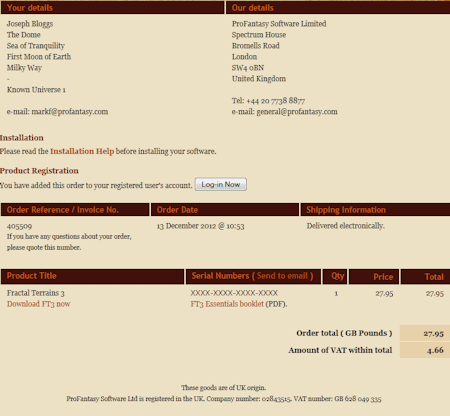
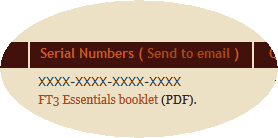
In the payment receipt there’s a very tempting Register button. Don’t click it! As this is a gift, leave registration for your recipient.
The Annual 2012 is our fastest selling annual since we started producing Annuals in 2007. We’ve had amazing user maps created and proudly displayed on our forum. Why? Well, I think the maps and comments speak for themselves. Here are my favourite styles for this year.
 Herwin Wielink‘s overland style was the single most popular style every created for the Annual, measured by the amount of maps shown on the forums. So popular in fact, that we published an extension of the style with more symbols and textures. Use Elothan said here “It is a dream to work with i must say, I originally got it for the isometric dungeons, but this style is good at it is almost worth the price of the annual alone”
Herwin Wielink‘s overland style was the single most popular style every created for the Annual, measured by the amount of maps shown on the forums. So popular in fact, that we published an extension of the style with more symbols and textures. Use Elothan said here “It is a dream to work with i must say, I originally got it for the isometric dungeons, but this style is good at it is almost worth the price of the annual alone”
Herwin also created another of my favourites – his isometric dungeon style is just extremely clever and beautiful. I used a map created in this style for my annual mammoth D&D session.
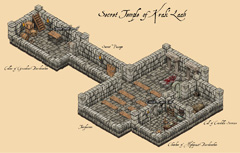 The user map in Herwin’s Overland style was done by Modric, and the isometric dungeon here by forum member Tommek, who even commissioned custom symbols for his map from another artist. There are other amazing maps in this style.
The user map in Herwin’s Overland style was done by Modric, and the isometric dungeon here by forum member Tommek, who even commissioned custom symbols for his map from another artist. There are other amazing maps in this style.
On top of this we have the 13th Age style – a look I didn’t think even Ralf could reproduce, but he surely did, and Clercon here shows us how to use it.
And these are just three of the many styles available from the 2012 Annual.
[Ed: Mike Schley is a renowned game cartographer with clients such as Wizards of the Coast, Paizo and Scholastic and aworking on a complete new overland style for CC3+]
 As a professional artist, I’ve produced a large body of work over the past decade and a half for clients ranging from game developers to public universities. Most recently, the majority of my fantastical cartography has been for publishers such as Wizards of the Coast and Scholastic Books. The opportunity to work with Profantasy came as a wonderful surprise since not only does it allow me to develop what I believe will be an awesome new addition to Campaign Cartographer, but it will also let folks that already like my work use a new style of it to let their own imaginations run wild. What could be better than that?
As a professional artist, I’ve produced a large body of work over the past decade and a half for clients ranging from game developers to public universities. Most recently, the majority of my fantastical cartography has been for publishers such as Wizards of the Coast and Scholastic Books. The opportunity to work with Profantasy came as a wonderful surprise since not only does it allow me to develop what I believe will be an awesome new addition to Campaign Cartographer, but it will also let folks that already like my work use a new style of it to let their own imaginations run wild. What could be better than that?
Years ago, when studying art in college, I would have never thought my career would develop into drawing intricate worlds and mythical lands. Now, as a full-time fantasy illustrator, I have difficulty imagining doing anything else. When I sit down to work every day, it’s like I’m transported back in time to being a kid again and drawing campaign maps for D&D or custom boards for all-night sessions of Risk. World building and visual storytelling are two of the most fun things I can imaging spending my days on and the fact that my audience gets a kick out of what I do is icing on the cake.

Combining the use of digital and traditional media, I try to convey a naturalistic visual style while benefitting from the clean and quickly editable properties of the digital format. For my work, it should look hand drawn, even if it’s done exclusively in Photoshop. I love the greats of the golden era of illustration like Rackham, Mucha, Pyle, and Wyeth and although I’m working in front of a screen and not an easel, it’s their art that informs my tastes. As for my cartography, it might also help that apparently I have ancestors such as Jacob van der Schley who also were enthralled by map making as far back as 18th century. Hooray for maps!

As you might have noticed I really like to make city maps. I don’t know why but I just love to see how a blank paper slowly turns into crawling streets and vast parks. It makes my imagination really spin.
Most of my city maps I make in the program City designer 3 (CD3) from profantasy. It is a great program with a huge toolbox you can use to make the creation of your cities a much smoother experience. To make the maps more unique I also like to edit them a bit in Photoshop afterwards.
When I bought CD3 my first impression of the program however was quite different. You can easily describe it in one word, overwhelmed. Just the sheer number of tools and objects made me fear for my mental health. The first time I started the program I think I just closed it immediately.
So how did I go from there to where I am now? Well the answer can actually be divided in three parts. First of all practice. I started out quite small with a little village and first after a couple of small practice maps I went for the bigger cities or towns. Secondly I looked up some tutorials, especially Gandwarfs tutorials over at the cartographer’s guild where extremely helpful. Thirdly there was a black and white city style released in the 2010 annual from Profantasy.
So what was so great with the black and white city style? First of all you get a very nice tutorial in every edition of the Annual, this makes it very easy to learn a new style, you can just follow the steps described. For me this meant a lot when it came to learning CD3, because I could in this way quickly pick up the different tools to use.
Secondly the amount of objects decreased quite a lot in the black and white city style compared to the coloured styles that were included in the actual program. This might sound a bit odd but the good thing here was that suddenly the program didn’t feel as overwhelming as before. When the choices in objects decreased, it kind of made it easier to grasp the program and find what you were looking for.
The map included in this post is a map that I made while trying to learn CD3. It was one of my first experiments to make a really large city map. I especially experimented a lot with the random street tool in this one. The random street tool is really a great help when you quickly need to fill and area with many houses.
When I was done in CD3 I opened the file in Photoshop and added some cliffs on the northwest side of the city. I also draw my own arena object to add to the city, I really missed that object in the style. As a finishing touch I made the map sepia coloured and placed the map on a paper background.
Well after that I just continued doing city maps and slowly the interface started to make sense and nowadays I rather feel that the there are too few objects in the program then too many ![]()
Originally posted on mappingworlds.wordpress.com
For my own ongoing Deadlands Reloaded campaign, I’ve created this battle map of a run-down home out in the Weird West. It’s based on the DD3 Battle Map template from the Annual Vol 2 and uses textures and symbols from DD3, Symbol Set 2 and the CSUAC. The roof texture on the upper level is from City Designer 3.
Click on the images below to load the full-size A3 pdfs.
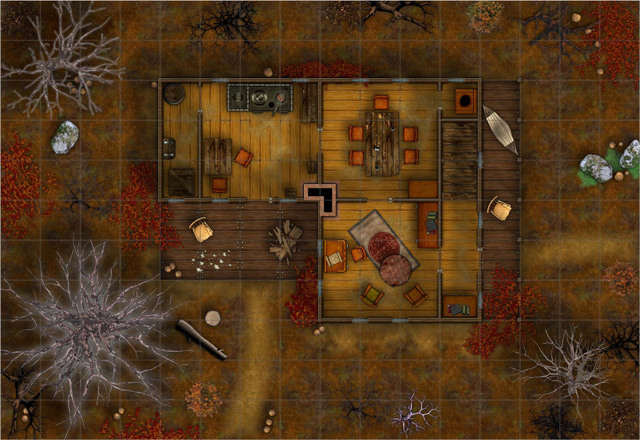
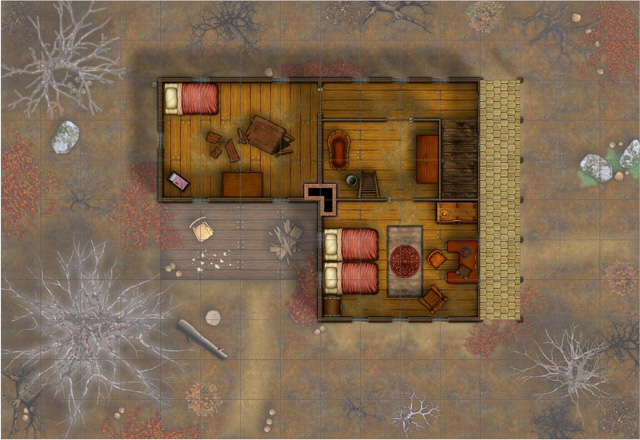
You can download the CC3+ version of the maps (FCW format) here, but be aware that you need all the afore-mentioned products to view them properly in CC3+.
Now that I’m safely back home, had a good night’s sleep (or two) and have sorted out all the boxes and stuff I brought back, I’m happy to report that it was another good year for ProFantasy at SPIEL. Games were played (few by me), fun was had (lots by me) and software was sold (by my stalwart helpers Gordon and Michael was well as me).
Spiel remains the huge affair that is has been with well over a 100,000 visitors (if not beyond 150,000). I’m sure they be announcing a new visitor record shortly. I get to see the usual mix of familiar faces and new people. It’s fun to hear “I wish this had been around when I was a GM!” from 30ish people. I can heartily assure them that our software WAS around when they were GMing.
We keep getting very good feedback from people using the software. One customer specifically congratulated us on the “excellent work with Symbol Set 3”. I am happy that the Annual Vol 5 was very popular (we almost sold out). Having a Jon Roberts Style map on the wall was one of the major drawing points and quite a few people took an Annual Vol 5 together with their CC3 purchase. Interestingly the popularity of DD3 and CD3 switched from last year, where City Designer was more popular. This time it was Dungeon Designer – perhaps in part because I had the big “Tendrils Oak Inn” poster not back on the wall, but lying on the table as a main display.
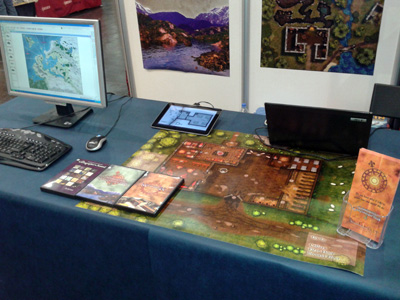 We did sell some fewer core programs this year, but made up for it with more add-ons. Dioramas was more popular than usual, which have to do with me having the Dungeon Diorama from the January Annual on the table. SS3 Modern didn’t do quite as well as I had hoped because interest in modern settings seemed generally lower (fewer Shadowrun players than usual). In contrast, we did get several inquiries about Steampunk artwork – a genre that is apparently still on the rise. Some customers purchased the new Tome, but generally customer at the booth prefer a hard copy to a download only which I can’t put into their hands immediately (same as the current Annual subscription). Both are much more popular in our web store in comparison. We sold two of our posters (the Kuslik city and the Tendril’s Oak Inn) on Sunday to a very keen customer (he kept coming back and asking me for my display posters).
We did sell some fewer core programs this year, but made up for it with more add-ons. Dioramas was more popular than usual, which have to do with me having the Dungeon Diorama from the January Annual on the table. SS3 Modern didn’t do quite as well as I had hoped because interest in modern settings seemed generally lower (fewer Shadowrun players than usual). In contrast, we did get several inquiries about Steampunk artwork – a genre that is apparently still on the rise. Some customers purchased the new Tome, but generally customer at the booth prefer a hard copy to a download only which I can’t put into their hands immediately (same as the current Annual subscription). Both are much more popular in our web store in comparison. We sold two of our posters (the Kuslik city and the Tendril’s Oak Inn) on Sunday to a very keen customer (he kept coming back and asking me for my display posters).
Demoing was mostly confined to CC3, DD3 and CD3 (more DD3 interest this time), with some Fractal Terrains, Dioramas and Cosmographer thrown in. While I switched to the Annual styles (e.g. the Jon Roberts style) a few times for demoing, the CC3 default Structures catalog is always good for a “Wow, that is VERY nice!” comment.
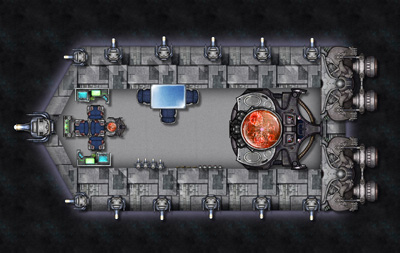 I was especially impressed with a perhaps 6 years old boy who created the map on the right. I demoed Cosmo 3 for his (much) older brother and he insisted on giving it a try as well. I gave him some pointers for the first few steps, then left him alone for 10 minutes or so. When I came back he had created this. I didn’t touch CC3 myself for this at all, except for exporting the map.
I was especially impressed with a perhaps 6 years old boy who created the map on the right. I demoed Cosmo 3 for his (much) older brother and he insisted on giving it a try as well. I gave him some pointers for the first few steps, then left him alone for 10 minutes or so. When I came back he had created this. I didn’t touch CC3 myself for this at all, except for exporting the map.
Overall I still think that the rpg part of Essen is slowly shrinking. The rpg hall (Hall 6) was definitely a bit smaller than last year (again), although most of that seemed to have been due to less LARP booths – the usual suspects of German rpg publishers and vendors were still there. Miniatures are also still strong, but a lot of “utility stuff” is creeping in, like card protectors for magic cards, carrying cases for miniatures and so on. Sunday had some rather quiet stretches, and the last hour before closing time is slow every day. I’d prefer a closing time of 6pm instead of 7pm (like at GenCon).
This year – due to it being school holidays – general attendance was high throughout, with a significant drop only in Sunday. Saturday of course remains the busiest day. This mostly affects the larger boardgame halls. While it was busier on Saturday in our hall too, we never had the kind of press that you get in the bigger halls. There are rumors that at least some of the halls will be torn down and rebuilt over the winter, but I’m not sure how much truth there is to this. It would certainly be nice for Hall 6, as it is getting a bit scruffy – and it is also rather dark compared to the other halls. And it would certainly benefit from easier access. Currently you have to walk quite a long way from the main entrance to get to the rpg hall.
I had Gordon at the booth to help me from Thursday to Saturday and Michael on Saturday and Sunday (giving me two helpers for the busiest day). They were invaluable as always. Apart from some strange problem of my usual adhesives not working on the booth walls anymore, setup and take down was smooth as always. If the Autobahn hadn’t been closed on my way home I’d have been home early.
I’m looking forward to next year’s SPIEL. See you there, boardgamers of the world.
Six years ago we began the Cartographer’s Annual, a monthly series of style, maps, and other cartogrpahic contents for CC3 and we thought it was about time for a little retrospective. The Annual has brought an immense wealth of style options to the ProFantasy community and we have been thrilled by all the beautiful maps our users have created. What better way than to highlight the the full scope of the Annuals than with some of these works of art?
2007 – Volume 1
 When we set out with the new concept of a subscription for Campaign Cartographer 3 users, we were really feeling our way around for what content was most popular. It quickly became apparent that new overland styles were the most popular type of Annual entry – but far from being the only thing people were looking for. We decided to strike a balance between generally popular topics like overland styles and more specific ones as seen in the “Parchment & Paper” June issue of 2007. The inaugural issue – the Mercator Historical style as shown on the right – represents the type of popular overland style that we strive to include in every volume of the Annual. The depicted map is by forum user Rogdor and was posted as a work-in-progress on the ProFantasy forum in March 2010, and there is another complete one here.
When we set out with the new concept of a subscription for Campaign Cartographer 3 users, we were really feeling our way around for what content was most popular. It quickly became apparent that new overland styles were the most popular type of Annual entry – but far from being the only thing people were looking for. We decided to strike a balance between generally popular topics like overland styles and more specific ones as seen in the “Parchment & Paper” June issue of 2007. The inaugural issue – the Mercator Historical style as shown on the right – represents the type of popular overland style that we strive to include in every volume of the Annual. The depicted map is by forum user Rogdor and was posted as a work-in-progress on the ProFantasy forum in March 2010, and there is another complete one here.
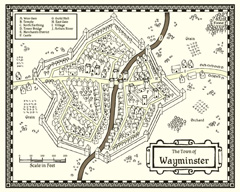 Another very popular and beautiful style from the first Annual is the John Speed City style, a black and white style emulating the city maps of famed British cartographer John Speed. Take a look at the map created by community member Modric.
Another very popular and beautiful style from the first Annual is the John Speed City style, a black and white style emulating the city maps of famed British cartographer John Speed. Take a look at the map created by community member Modric.
Other highlights of the Annual 2007 include the multi-level floorplan of the “Tendril’s Oak Inn” complete with description and adventure ideas, an overland style based on the artwork of Sarah Wroot ( a user map here), and a tutorial on how to create your own drawing styles from scratch.
We received very positive feedback on the Annual 2007 – users were enthusiastic – which made the decision to continue the subscription model an easy one. And we were able to start the second year with a real bang as we got permission from one of the rpg industry’s cartography legends to emulate him: Pete Fenlon of Middle-earth roleplaying fame allowed us to recreate the style he used for those beautiful maps of Middle-earth.
The map here was created in the Pete Fenlon style (again by Modric) just recently, proving that the old style from the early days of the Annual are still used to great effect.
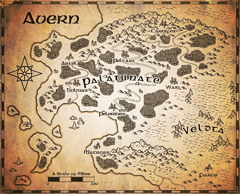 As a second overland style for 2008 we produced a black and white vector style which also proved very popular. So popular in fact, that we added a simiular – but distinct – b&w style to Campaign Cartographer 3 as a free download.
As a second overland style for 2008 we produced a black and white vector style which also proved very popular. So popular in fact, that we added a simiular – but distinct – b&w style to Campaign Cartographer 3 as a free download.
The sample map on the left shows ever-prolific Modric using the style with a parchment filter to create a beautiful in-game artifact.
As a special highlight the 2008 Annual saw the first video tutorials for CC3 produced by Joseph Sweeney. His videos have become a staple of introducing new users to CC3 and by now he has created a whole range of them for various products and add-ons.
2009 started with a style created by Master Mapper Allyn Bowker. The Fantasy Realms style captures the look used in some Forgotten Realms maps and still produces pangs of sweet nostalgia in many people who see it. Originally the style was produced for CC2, but the lack of drawing tool functionality made it hard to use by anyone a little less meticulous (and may I say “brilliant”) than Allyn. CC3 allowed Allyn to make the look easier to use and, with sheet effects, more attractive. Here you can see forum user Henrie61 applying the style to a custom world.
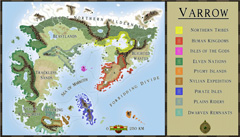 The 2009 Annual also saw another artist contributing his first style to the subscription: Pär Lindström. His beautiful world map caught our eye and although he did not use CC3 at the time, we came up with a way to transfer bitmap-based art into a CC3 drawing style. The artist supplies us with layered Photoshop files of his work and we extract the symbols and textures and convert them to assets in CC3.
The 2009 Annual also saw another artist contributing his first style to the subscription: Pär Lindström. His beautiful world map caught our eye and although he did not use CC3 at the time, we came up with a way to transfer bitmap-based art into a CC3 drawing style. The artist supplies us with layered Photoshop files of his work and we extract the symbols and textures and convert them to assets in CC3.
The Fantasy Worlds style proved extremely easy to work with, so that first time users of CC3 managed to create very beautiful maps. The example here was done by Neilander as a first map!
As we had learned from the black and white overland style in 2008, monochrome maps where quite popular (in part certainly because they print easily), so we decided to add dungeon and city styles in b&w to the 2010 Annual. Especially the city style became a fan favorite. The example shown on the right was created by community member bearclaw and shows the beautiful layout of a riverside town.
 Another option for quick and easy maps that’s popular with role-players is the hex-based map. Back with Cosmographer Pro hex map functionality was introduced to Campaign Cartographer, and with the Annual 2010 we added a new style for old-school fantasy overland maps. Here you can see forum member Skycast using the style to create the map of a wooded peninsula.
Another option for quick and easy maps that’s popular with role-players is the hex-based map. Back with Cosmographer Pro hex map functionality was introduced to Campaign Cartographer, and with the Annual 2010 we added a new style for old-school fantasy overland maps. Here you can see forum member Skycast using the style to create the map of a wooded peninsula.
2011 was undoubtedly the year of fantasy cartographer Jonathan Roberts. We can across his beautiful work on the web and asked him whether he’d be willing to produce a couple of styles for us. He obliged and the Annual 2011 could boast both an overland and a dungeon style created by him. We even made the dungeon style available for free at the end of the year.
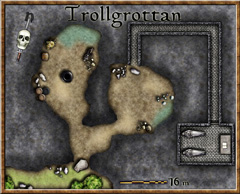 Community member Koth produced the gorgeous map called Kern’s End shown here, by exporting a coastline he liked from Fractal Terrains 3 and then build upon with the Jon Roberts Overland style.
Community member Koth produced the gorgeous map called Kern’s End shown here, by exporting a coastline he liked from Fractal Terrains 3 and then build upon with the Jon Roberts Overland style.
Pär Lindström (who writes on this blog) used the matching dungeon style to create this little encounter map for a role-playing session with his children.
As 2011 was the year of Jon Roberts, 2012 will prove the year of another great fantasy cartographer: Herwin Wielink. His overland style (going by his DeviantArt handle “Djekspek”) was the single most popular style every created for the Annual, measured by the amount of maps shown on the forums. So popular in fact, we will be publishing an extension of the style with more symbols and textures in November. And his isometric dungeon style is just extremely clever and beautiful. We are thrilled that all new artwork from Herwin will also be included in the upcoming Perspectives 3.
 The user map in Djekspek’s Overland style was done by Modric, and the isometric dungeon here by forum member Tommek, who even commissioned custom symbols for his map from another artist. There are other amazing maps in this style.
The user map in Djekspek’s Overland style was done by Modric, and the isometric dungeon here by forum member Tommek, who even commissioned custom symbols for his map from another artist. There are other amazing maps in this style.
Conclusion
When we started with the Annual back in 2007 we hardly imagined that we would be able to fill six years of subscription with material and keep everyone’s interest. But now the Annual is still going strong and the new and amazing talent within and without the ProFantasy community means we can rely on a steady influx of new ideas for upcoming issues. We’ll keep it coming.
The Annuals website is here, and you can see the full range of styles and other content on the gallery pages.
The latest articles and news from ProFantasy
News
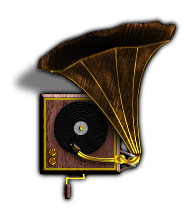
Resources
Map-making articles
I’ve subscribed to the Profantasy Annuals since the beginning and I must say that it has been a great investment. I’ve learned a lot from the included PDF’s that comes with the monthly style and most of the styles are really great. But then sometimes there is a month when you think “when will I ever use that style!”. But you should never say never, suddenly you might have use for a style you thought you’d never touch.
This happened to me when it comes to the 2010 Annual May edition, Abstract maps. When I received it I first thought it was a real waste of space on my hard drive. When would I ever use that, but that was before I went to London with my son.
When my son was eight I took him on a trip to London. They had just started to learn English in school and I thought that going to England would be a great way to motivate him to learn the language. Of course we could also have a great time visiting museums and interesting landmarks like Big Ben and the London eye.
As it turned out he got really hooked on the Underground. We don’t have one where we live and for a child it is fascinating to go on a train far below the surface. We ended up doing a lot of travelling with the underground and we even bought a London underground game that we’ve played while coming home again.
After returning to Sweden my son thought it was fun to play that he was travelling with the underground, pretending that different rooms in the house where stations. I suddenly remembered that I had a style for CC3 where you could make underground maps. Quickly I started the program and made a map for him where all rooms where stations and different lines went to different parts of the house. I even added some lines that continued out in the garden.
So you should never rule out a style, who knows in the end you might have a use for them all.
Republished from Mapping Worlds.